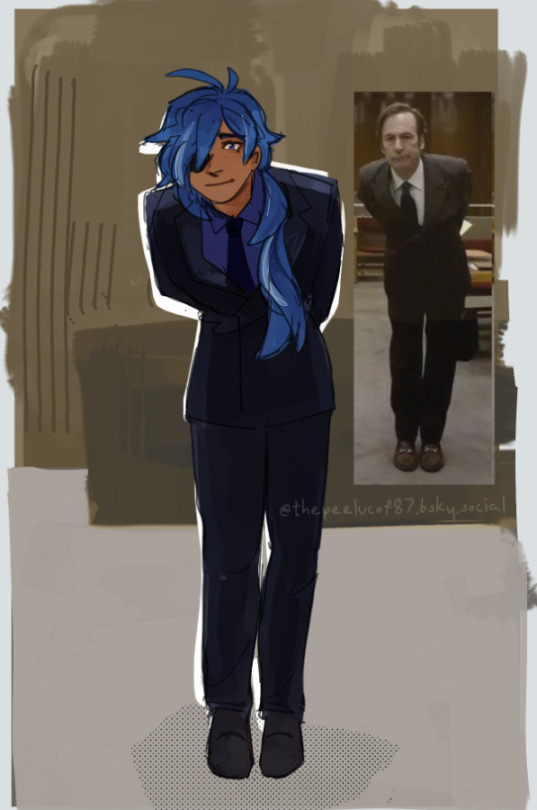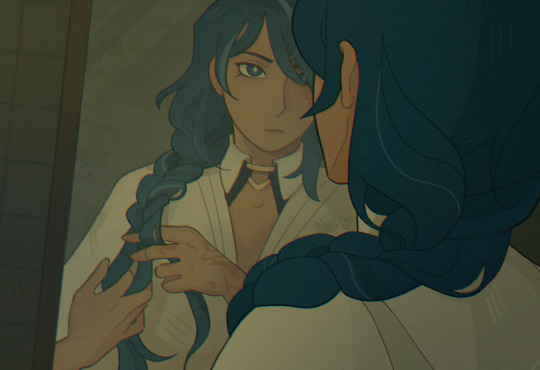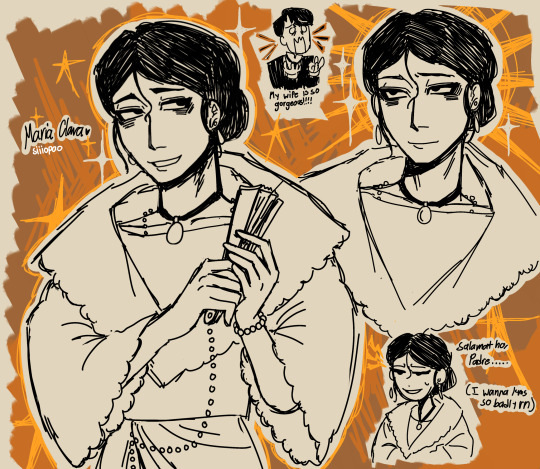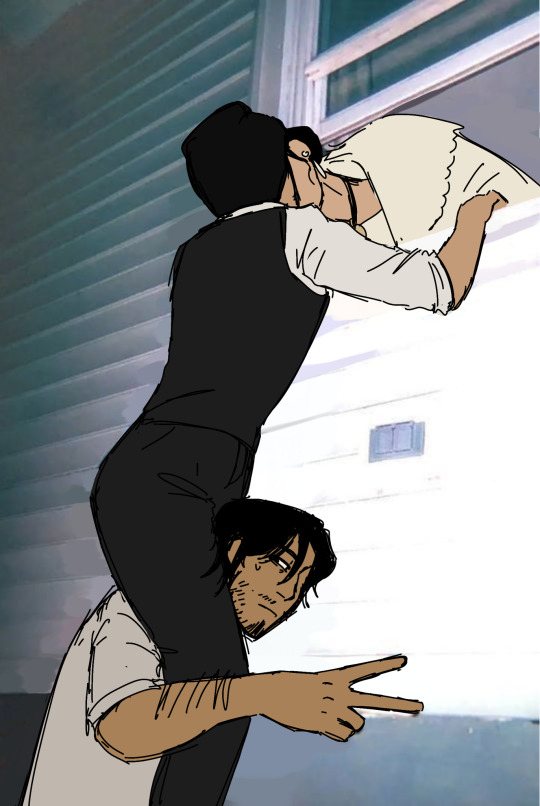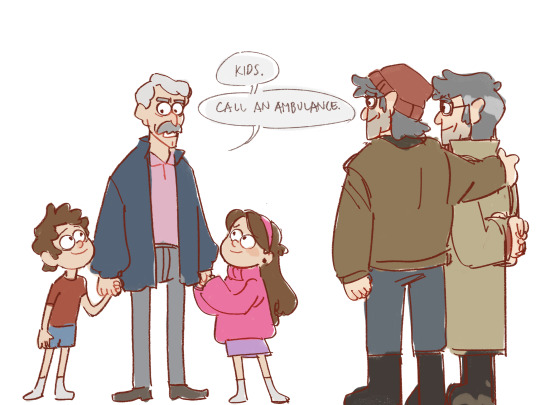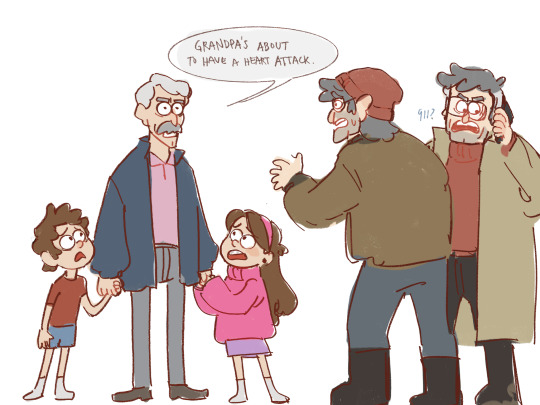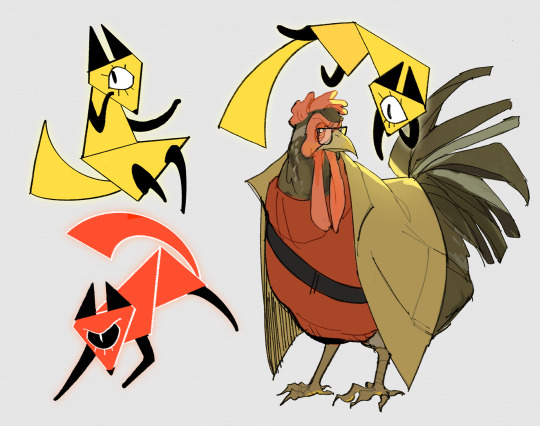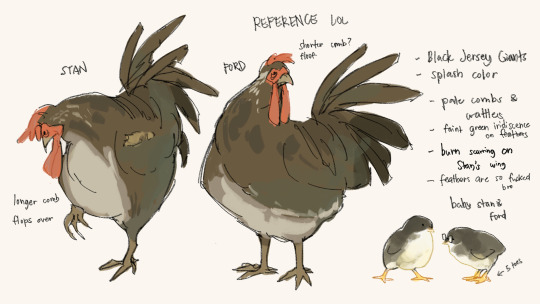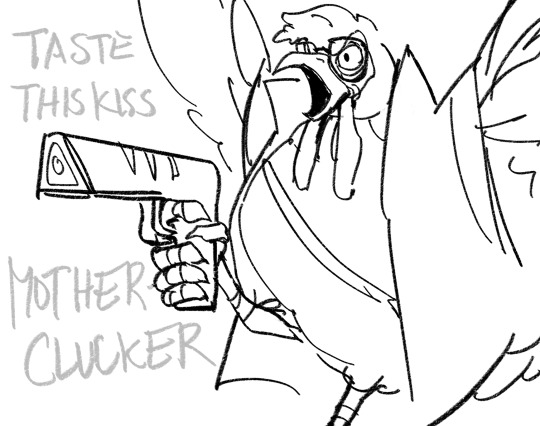aro-ace flux intj-t*:・゚busy note-taking*:・゚let's go and play those games that you like
Last active 3 hours ago
Don't wanna be here? Send us removal request.
Note
Hello! How are you doing??
Can I request cute and fluffy moments with damon and kai? Like just silly cute daily stuff they do with reader


MOMENTS WITH THEM featuring. damon maitsu, kai monteago and wolfgang akire.
hiii i hope this fits what you'd requested. hope you enjoy it. some actual writing and some small silly headcanons ! i see all your requests and ill try my best to work. expect another post maybe after christmas! three feinyan posts in a week .. who is this …?

# damon maitsu
laying on the couch together, resting practically atop of him, face close to his own with your body positioned between his legs. elbows digging into his chest as you ramble and giggle on endlessly about your day. he’ll suddenly raise move hands, sliding them toward your waist and giving it a big squeeze. the cold fingers against your bare skin catch you off guard, and it sends you tumbling down (not a very far distance, albeit) with your head into his chest. he snickers at you with a smug grin as you give him a lecture.
internally fights himself to not completely melt into your touch. he feels like a dumbass when he does. its conflicting. standing in front of him, fingers intertwined within his own, leaning in close enough to feel his breath against your skin. parting your lips and sliding a thigh in between his own, he stumbles backwards, pulling away from your touch. the two of you sort of shoot looks at each other in confusion. damon, a flustered mess, muttering to slow down and give him a second to process it. he wants it, but hes nervous. too nervous to process your touch, too nervous to process even just the way he feels. if things go too quick for him, he feels like his brain will turn to mush. these type of moments make you giggle. a humored hum escaping your lips whilst he gives you an embarrassed look, biting his lip whilst unable to refute your laughter. but you don’t mind it with ill intent, and he’s aware of that. his need for your patience, his nervous grin, his shaking fingers. its all too cute when he overheats in the moment.
soooo annoying in the morning. its a daily occurrence. grumbles about still being tired, burying his face into your chest in order to shield his eyes from the sunlight interrupting through the blinds. you’ll literally have to drag him out of bed or annoy him with whining and babbling till he wakes up if you want to get anything done on time. such a sleepy love bug, clinging to you as if he didn’t have a care in the world showing affection.
rough with how he touches you. always. in a way, its a reminder of him. something you like. something special. his way of attempting to be gentle with you yet always managing to be harsh with his fingers or lips is amusing, so you feed him praise nonetheless.
i think he would lean on you a lot. if you’re short enough, he stands behind you, hands on your head and resting his own atop of them.
communicates with you with eye contact. if you’re out with friends and he wants something, he’ll indicate it with his eyes. annoyed? rolls his eyes. confused? gives you a weirded out stare. silly stuff like that. you’ve practically mastered damon eye language by now.
coldest hands. literally ever. his body always feels like he’s ridded with frostbite, stranded in the midst of a winter storm. even in summer.
# kai monteago
pathetic. full stop. has a habit of running to you whilst whining, burying his head into the crook of your neck or clothing, and begging for protection from you. ‘baaaaaaby, damons picking on me again. say something to him! tell him to leave me alooooooneee …’
always caught up on petty celebrity drama and gossips about it with you. texts you as soon as he hears something new, always making sure to keep you updated. bursting into your room, closing the door abruptly behind him whilst throwing himself against your mattress, phone in hand. ‘guessssss what i just found out!’ rambling about dumb internet drama was a topic frequently brought up between the two of you, whether its a hot topic going around the internet as of now, or something he just happenedddd to stumble across. and just happenedddd to tell you about it in detail the minute he heard.
sends pictures of himself to you almost every time you’re apart. he misses you, and he wants you to see his gorgeous face even when you’re apart! constant facetimes, a lot of texts updating you on his day or whining about work, etc.
dummy who uses internet slang with you expecting you to immediately understand. and when you don’t, he acts like its the most shocking thing in the world. ‘babe. how do you not know what rizz means?? its literally everywhere!’
takes pictures of literally everything for social media. food? check. scenery? check. himself? double check.
you two do your nails together .. or you’ll try out makeup products or little trinkets you’d found on each other.
alwaaaays takes you out when he goes shopping. never goes without you, its just routine. thrifting, expensive, grocery, anything. its as if he couldn’t make decisions without you there.
takes pictures of you so often! he just love loves looking at you, whether or not you look inherently ‘good’ or not. he always thinks you look lovely. he def has a photo album of you.
# wolfgang akire
has a routine to leave a kiss against your forehead every morning. even if the two of you are just spending a day in bed together, whether you’re awake or not when he’s preparing to leave for work. he’ll brush your hair out of the way, gently placing his lips against your forehead with a quiet, ‘i love you, i’ll see you soon, my darling’ as to not wake you up.
frequently showers with you. not in a sexual way, but in a way where you two just view each other in such a vulnerable state. a way of being closest to each other in a way nobody else could, giggling or talking over the loud pounding of the water hitting the shower floor, washing each other. wolfie running his fingers through your hair, thoroughly scrubbing at your scalp in order to wash any excess soap out. humming softly, his eyes steadily locked on his working fingers as he’d mutter out a usual, quiet, ‘hold still, i’m almost done sweetheart.’
kisses parts of your body you’re insecure about. scars, moles, any feature you dislike. but he just can’t find a way to dislike anything about you, he cherishes every part of your body, and he won’t forget to remind you of that.
frequently takes toshiko out on little adventures with you. to an arcade, an amusement park. anywhere wolfie thinks both of you will have fun. to him, seeing two people he loves, a girl whose like a little sister to him and you, someone who he’d go to hell and back for giggling and chatting together warms his heart in an unexplainable way.
lends you clothes. usually his sweaters or jacket, but he just wants you to be warm, hes always concerned if you two are out in the winter. bundles you up in a jacket, a scarf wrapped around your neck and big poofy gloves covering your hands.
sends you lovely, sweet messages randomly. throughout the day, he’ll ask if you’ve eaten or what you plan to do today. he’ll call you on break or when given the opportunity. hes always making sure he has time for you, and maybe worrying a little too much.
calm, rarely argues with you. its reassuring the way he listens to you and understands you.
def surprises you with your favorite types of food or flowers after a long day! he knows just how to take care of you.
sometimes he'll come home in a bad mood after work, and you can return the favor! surprising him with things he enjoys, making him a nice warm meal or just comforting him. your words with each other mean a lot.

@ feinyan
222 notes
·
View notes
Text
Thinking about the leader being sick or stealthily poisoned/drugged and deteriorating during an important op. Everybody looking to them for the plan and getting confused/frantic as they're making less and less sense by the minute, possibly at risk of giving conflicting orders or making too much noise or blowing their cover or just straight up passing out and leaving the second-in-command to scramble and compensate, especially if it was a "We only have one shot to do this" sort of deal
328 notes
·
View notes
Text
Life and Death in the ER: Dr Lindsay
*Good evening everyone, I hope all is well. I greatly appreciate all the positive feedback on my last story Alexa's Arrhythmia! I'd like to try something a little different with the story you're about to read. Although it may not be everyone's cup of tea, I think it's a great opportunity for you guys to get to know some of our go-to characters a little better. Anyway, I hope you guys enjoy it!*
Aside from medicine, Dr Lindsay’s passion in life is running. The cute, sporty tomboy doctor we all know and love was a college track star at the D1 college she attended once upon a time ago. Believe it or not, Lindsay had legitimate Olympic aspirations, and at one point in time, she was set to qualify for the United States women’s track team. But fate had other plans, which came in the form of a sudden, severe ACL and LCL tear in her left knee. Reconstructive surgery was performed and she of course recovered, but Lindsay definitely lost her X factor. Even though Lindsay could still run circles around 99% of humanity as a 33 year old with a bum knee, she lost that slight edge all those years ago, which is all it took for her Olympic hopes and dreams to go up in smoke. Sometimes Lindsay thought “what if?” in regards to her potential professional sports career, but at the same time, being an ER physician fulfilled her in a different way.
Lindsay truly embraced her role as a doctor and caretaker in the emergency department, always going the extra mile for her patients and thinking outside the box to try to save them. Time after time, Dr Lindsay found herself in the midst of life and death struggles in the trauma bay, always seeming to have her hands inside the chest of a beautiful woman. But right now, somewhere in an alternate reality, the role was reversed, with Lindsay being the beauty fighting for her life in the all too familiar emergency department.
The room Lindsay found herself in was quite a scene. A cacophony of sound hit anyone the instant they set foot in the room. Alarms and monitors were going off. Orders were being barked. Footsteps pitter-pattered around the room. The high pitched, electrical whirring of defibrillators charging echoed around the room from yet another unsuccessful shock. The tension was palpable.
All across the floor of the room, various items were strewn about. Wrappers from bits of medical equipment were tossed to the ground. Empty, used up blood transfusion and IV bags found themselves discarded. Lindsay’s bloody, tattered clothes also wound up on the light colored tile after a brief encounter with a set of shears. Small droplets of blood made a trail leading from the room’s entrance, all the way over to where the trauma room table was.
On the table, underneath the harsh, bright, fluorescent overhead light was the center of attention for the room’s occupants. Dr Sarah, Nurse Nancy, and Nurse Heather worked as a trio, each lady knowing their role inside out, backwards and forwards, from A to Z. Everyone knew their jobs at an expert level, but it was easier said than done for the emergency department’s triumvirate to maintain composure and impartiality, considering a friend and colleague was the poor soul requiring their lifesaving services this time.
Nurse Nancy, the 20+ year veteran of the ER who’s been there, done that, and seen it all stood at the head of the bed ambu bagging, sending much needed air into Dr Lindsay’s lungs. The stress, chaos, gore, and shock that came with being an ER nurse never fazed Nancy, especially after being exposed to such things for over two decades. But in this scenario, Nancy struggled. This wasn’t a stranger on the table tonight. Nurse Nancy couldn’t wrap her head around the idea of the ER’s go-to, unanimously loved leader being the one on the table this time. Heck, Nancy couldn’t even bring herself to look down at the table, not wanting to see her friend’s face, or the overall shape she was in. There was a knot in Nancy’s stomach, and her heart was racing. She hoped and prayed Dr Lindsay would pull through, but as each minute ticked by, each one faster than the last, Nancy’s hope was soon replaced by dread.
Heather, our emergency team’s dependable, hardworking nurse who regularly showed her moxie, stood off to the side of the table, tasked with keeping an eye on the heart monitors in order to note any changes, as well as pushing meds and setting up any equipment Dr Sarah may need. Heather’s eyes were trained on the heart monitors, which displayed a squiggly, sinuous, unorganized line. That squiggly line Heather watched signified something called ventricular fibrillation- a situation where a patient’s heart is twitching instead of actually beating, typically requiring a defibrillator shock in order to restore normal cardiac activity. Ventricular fibrillation, commonly known as v-fib amongst healthcare professionals, was something Heather has seen more times than she could count during her handful of years as a nurse. However, Heather found herself stunned when eyeing the heart monitor, coming to the stark realization that a familiar face was the one being resuscitated this time.
Dr Sarah, the cute, petite, nerdy redheaded doctor who, for all intents and purposes, was Dr Lindsay’s right hand man and most important ally in the battlegrounds of the trauma bay, stood right up against the table, doing anything and everything to bring her fellow ER doc back. Sarah had her gloved hands inside Lindsay’s chest, which was splayed open earlier in the struggle via a clamshell thoracotomy. The redheaded doctor’s hands were firmly wrapped around Dr Lindsay’s boggy, fibrillating heart, vigorously massaging away. A wet, rhythmic squishing sound was produced from Sarah’s internal compressions. “come on Linds… come on….” Sarah uttered under her breath, trying to fight the overwhelming emotions that attempted to consume her. “You were just talking to us Linds… Come on…” continued Sarah, trying to will Lindsay back amongst the living.
Sarah composed herself for a moment. “Let’s shock her again. Recharge the paddles to 30, Heather.” Ordered Sarah, stepping up to the plate. Heather did what she had to do. She set the crash cart to 30 joules and hit the charge button. The high pitched, electrical whining of the internal paddles charging filled the room as Heather handed Sarah the large, spoon shaped devices. Sarah pulled her hands out of Lindsay’s chest cavity and grabbed ahold of the internal paddles. Dr Sarah lowered the internal paddles into the gaping chasm of an incision site, around Lindsay’s erratically fluttering heart.
While her friends worked urgently to save her, Lindsay laid on the table, stripped completely nude, her toned, athletic body on full display in a room full of familiar faces, the violating nature of that fact going to the wayside due to the dire essence of the situation. Lindsay’s sandy, light brown hair was tied back in a messy bun or ponytail of sorts, being held in place with a black headband. The doctor’s icy, sky blue eyes remained open, her pupils the size of dimes, staring up above with a full blown death stare etched onto her face. She was intubated, with the ET tube being secured by a blue tube holder around the area of her mouth and lips. IV lines stuck out of both her arms. Her torso was littered with EKG electrodes and wires. A chest tube stuck out the left side of Lindsay’s ribs, redirecting blood and trapped air outwards. The rest of her upper torso, and belly to a lesser degree, were soaked with a combination of both blood and betadine. However, Lindsay’s chest was the main sight of shock and awe. Her chest had a large, crude, gash just below the nipple line, extending the entirety of her chest horizontally. Not only was there a massive gash, her sternum was sawed in half, and her chest was splayed open via a clamshell thoracotomy. A metal rib retractor sat dead center in her chest, keeping everything open. A large, metal vascular clamp stuck up and out of the incision site. Sarah could also be seen holding the internal defibrillator paddles in place in anticipation of a shock.
“Paddles charged. Everyone… CLEAR!” Dr Sarah called out, everyone else stepping back from the table. THWACK. The shock was delivered. “mmmph…” Lindsay moaned softly, her torso twitching sharply in response to Sarah’s shock. The trio paused after the shock. The monitors beeped fast and loud, everyone’s eyes looking over to see if there was a change. “Come on… she’s still in v-fib. I’m going again at 30. Everyone…. CLEAR!” shouted Dr Sarah, immediately shocking Lindsay again. Lindsay’s shoulders shrugged forward and her arms shivered, a wet thump being heard. Like before, Dr Lindsay’s heartbeat was unable to be restored. Sarah decided to up the ante, shocking her friend and coworker at 40 joules during the next go around. “MMMM!” Lindsay moaned louder, as if she could feel the stronger intensity of the shock. Again, v-fib persisted. “I’m going again at 40! Everyone…CLEAR!” Barked Sarah, determined to keep going. The next shock caused Lindsay’s toes to scrunch up hard at the far end of the table, showing off the bright white nail polish on her toes, along with the wavy, thin, but prominent wrinkles that permeated the soles of the big, size 11 feet she was always so self conscious of.
Sarah wasn’t giving up, and neither was v-fib, so the fight was on. “Going again at 40! Everyone… CLEAR!!!” Sarah passionately yelled out, shocking Lindsay once more. Lindsay’s torso shot up and plopped back down hard all within the span of a second. The monitors kept alarming, but by that point, the trio tuned out the noise of the monitors, considering they were well aware there was a major problem. In the seconds after that shock, Lindsay’s heart fluttered and danced weakly for a moment, before coming to a sudden, complete stop. The heart monitors flatlined, and Lindsay’s heart sat completely motionless inside her cracked open chest. Lindsay’s beautiful blue eyes stayed wide open, staring up above, almost as if she was watching her friends determine their next move.
The flatline on the monitors was an absolute gut punch for everyone. Sarah stood there holding the internal paddles, deep in rumination about her next move. At the head of the bed, Nurse Nancy shined a pen light into Lindsay’s eyes. Lindsay’s pupils were the size of dimes, completely blown, not reacting to the pen light in the slightest. “oh… poor baby…” Nancy uttered, placing the pen light back in her breast pocket. “Pupils fixed and dilated.” Nancy continued, informing everyone, shaking her head. Heather looked over at the heart monitor. “Asystole on the monitors, down 37 minutes.” Added Heather. There was a collective pause after Heather’s words. Nancy didn’t say anything, but she went ahead and detached the ambu bag from the ET tube, a small amount of air quietly hissing out. The two nurses looked over at Sarah, knowing they’ve done all they could for their friend, but needed Sarah to make the final call.
Dr Sarah stood there shell shocked. Sure, Sarah has lost patients before- any ER doctor has. But this was different. This was a coworker. A colleague. A leader. Someone she looked up to. But most importantly, this was a friend. Sarah felt morally and emotionally obligated to continue resuscitation efforts. How could she just give up on Lindsay? At the same time, Dr Sarah viewed the situation clinically and logically. She knew that all possible options were exhausted. An asystolic patient with a downtime of 37 minutes and blown pupils was too far gone for additional interventions. With all this in mind, Sarah snapped back to reality, eyeing each member of the trauma team. Dr Sarah didn’t say a word to any of them. Finally, her eyes looked over at the clock that sat on the back left wall of the room. Sarah gently placed the internal paddles back down on the crash cart, then peeled her blood soaked, latex gloves off, her heart racing, eventually making the dreaded announcement. “Time of death, 8:08pm…” Sarah’s voice wobbling, on the verge of tears.
Nobody said a word, but everyone knew exactly what to do next. Nurse Nancy switched off the flatlined monitors, silencing the once noisy, hectic room. Heather disconnected the EKG electrodes and removed the IVs from each of Dr Lindsay’s arms. A blue surgical drape was hastily tossed on top of the open thoracotomy site, obscuring Lindsay’s inert, motionless heart from view. A toe tag was then filled out and placed on the big toe of Lindsay’s left foot. The tag dangled against the fine, thin, but prominent wrinkles that permeated the soles of Lindsay’s feet. Lastly, a cover was placed over Lindsay, concealing the hauntingly beautiful gaze forever etched onto her face. Unfortunately for Lindsay, a cruel twist of fate- and perhaps irony resulted in her dying in the very place she spent so much of her time. In this alternate reality, Dr Lindsay was now the hottie who laid toe tagged and under a sheet in the emergency department.
90 notes
·
View notes
Text
A Writer's Blueprint for Realistic Drowning Scenes

This guide is designed to help writers depict drowning scenes with authenticity and detail. I’ll walk you through the step-by-step process of drowning, the physical signs to look for and clear up some common misconceptions. With this information, you’ll have the tools to craft vivid, compelling, and believable drowning scenarios that will captivate your readers and add depth to your narrative.
Fair warning; this is a comprehensive and pretty explicit guide, so if you're uncomfortable with those topics, please just scroll away.
The Stages of Drowning
1. Initial Entry
When a person first enters the water, especially unexpectedly, their initial reaction is often one of shock and panic. The sudden change in environment, temperature, and the feeling of being submerged triggers an immediate response from the body.
Shock Response
Cold Water Immersion: Sudden immersion in cold water can cause a cold shock response, which includes involuntary gasping, hyperventilation, and a rapid increase in heart rate and blood pressure.
Panic and Disorientation: The person may become disoriented and panic, struggling to stay afloat and breathe normally.
2. Involuntary Breath-Holding
As the person struggles to keep their head above water, they instinctively hold their breath to prevent water from entering their lungs.
Burning Sensation in Lungs
The buildup of carbon dioxide in the blood creates a burning sensation in the lungs, which intensifies the feeling of panic.
Increased Heart Rate and Blood Pressure
The body's stress response causes an increase in heart rate and blood pressure, further depleting oxygen reserves.
3. Uncontrolled Breathing
When the person can no longer hold their breath, the body's reflexes take over, leading to involuntary attempts to breathe.
Aspiration of Water
Water enters the mouth and is aspirated into the lungs, causing coughing, choking, and a strong gag reflex.
Coughing and Choking
The person may cough and choke as water enters the respiratory tract, leading to more panic and struggle.
Gasping for Air
The body's desperate attempt to get oxygen leads to gasping, but often results in inhaling more water.
4. Laryngospasm
The body's protective reflex to prevent water from entering the lungs can cause the vocal cords to spasm, temporarily sealing the airway.
Temporary Airway Closure
The laryngospasm closes the airway, preventing both water and air from entering the lungs.
Increased CO2 and Decreased O2
As carbon dioxide levels rise and oxygen levels fall, the person becomes increasingly hypoxic.
5. Loss of Consciousness
Due to the lack of oxygen, the person loses consciousness.
Hypoxia and Hypercapnia
Hypoxia (lack of oxygen) and hypercapnia (excess carbon dioxide) cause confusion, dizziness, and loss of motor control.
Fading Senses
Vision blurs, hearing diminishes, and the sense of touch becomes numb.
Blackout
The brain, deprived of oxygen, shuts down, leading to unconsciousness.
6. Cardiac Arrest
Prolonged oxygen deprivation leads to cardiac arrest, where the heart stops beating.
Cessation of Breathing
Respiratory effort ceases as the brain's control over breathing is lost.
Heart Stops Beating
The heart, deprived of oxygen, stops beating, leading to complete circulatory failure.
Brain Damage and Death
Without intervention, brain cells die from lack of oxygen, leading to permanent brain damage and eventually death.
7. Aftermath (if Rescued)
If the person is rescued and resuscitated, there are immediate and long-term consequences to consider.
Immediate Aftermath
CPR and First Aid: Immediate resuscitation efforts, including CPR and the use of a defibrillator if necessary.
Hospitalization: The person will likely need to be hospitalized for further treatment and monitoring.
Long-Term Effects
Lung Damage: Inhalation of water can cause damage to the lung tissues, leading to conditions like pneumonia or acute respiratory distress syndrome (ARDS).
Neurological Damage: Prolonged lack of oxygen can result in brain damage, affecting cognitive and motor functions.
Psychological Impact: Survivors may experience PTSD, anxiety, and a lasting fear of water.
Physical Appearance During Drowning
1. Initial Entry
Shock Response
Wide Eyes and Gasping Mouth: Eyes are wide open, and the mouth is often open in a gasp or scream.
Flailing Limbs: Arms and legs are moving rapidly in an attempt to regain balance and stay afloat.
2. Involuntary Breath-Holding
Tensed Muscles
Rigid Body: Muscles are tensed, and the body may appear stiff as the person tries to maintain control.
Strained Facial Expression: The face may show strain, with furrowed brows and tightly closed eyes.
3. Uncontrolled Breathing
Coughing and Choking
Reddened Face and Eyes: The face may turn red from the effort of coughing and choking.
Foaming at the Mouth: A frothy mixture of saliva and water may be visible around the mouth.
Gasping for Air
Open Mouth and Wide Eyes: The mouth is open wide in an attempt to gasp for air, and the eyes may be bulging with fear.
Erratic Movements: The person’s movements become more erratic and uncoordinated as they struggle to breathe.
4. Laryngospasm
Silent Struggle
Mouth Opening and Closing: The person may appear to be gasping silently as the airway is temporarily sealed.
Clenching Throat: Hands may instinctively clutch at the throat in a futile attempt to open the airway.
5. Loss of Consciousness
Limp Body
Floating Limply: The body becomes limp and may float face down or sink slightly below the surface.
Pale or Blue Skin: Skin may turn pale or blue (cyanosis) due to lack of oxygen.
Relaxed Facial Features
Closed Eyes: Eyes close as the person loses consciousness.
Slack Jaw: The jaw may go slack, and the mouth could be partially open.
6. Cardiac Arrest
Unconsciousness
Still Body: The body is completely still, with no voluntary movements.
Gray or Blue Skin: Skin color becomes ashen, gray, or blue, particularly around the lips and extremities.
7. After Drowning (Post-Rescue Appearance)
If the person is rescued, their appearance post-drowning can indicate the extent of their ordeal and the immediate aftermath.
Immediate Aftermath
Waterlogged Clothing: Clothes may be heavy and waterlogged, clinging to the body.
Coughing and Vomiting: The person may cough up water or vomit as they are resuscitated.
Shivering: If the water was cold, the person might be shivering uncontrollably due to hypothermia.
Long-Term Appearance
Bruising and Cuts: There may be bruises or cuts from the struggle in the water or the rescue process.
Pale or Blue Skin: Skin color might still show signs of cyanosis if oxygen levels are low.
Labored Breathing: Breathing may remain labored and shallow as the lungs recover.
Ways to Drown
Being Tied Down with a Stone
An ancient method where a person is weighted down with a heavy object, preventing them from surfacing.
Pulled Under by a Strong Current
Strong currents or rip tides can overpower a swimmer, pulling them away from safety and making it difficult to stay afloat.
Trapped Under a Capsized Boat
In the event of a boat capsizing, a person can become trapped underneath, unable to reach the surface for air.
Caught in Underwater Vegetation
Dense underwater plants can entangle a swimmer, restricting their movements and preventing them from surfacing.
Unable to Swim in Deep Water
Lack of swimming skills or fatigue in deep water can lead to drowning if the person cannot keep themselves afloat.
Falling Through Ice
Falling through thin ice can trap a person in freezing water, with the ice making it difficult to find an exit.
Getting Caught in a Riptide
A riptide can drag a swimmer out to sea, making it hard to swim back to shore due to the strong current.
Swimming Exhaustion
Overexertion while swimming can lead to exhaustion, making it impossible to continue treading water or swimming to safety.
Diving Accident
A diving mishap, such as hitting one’s head or getting disoriented underwater, can result in drowning.
Shipwreck
In a shipwreck scenario, a person may be stranded in open water, facing potential drowning due to exhaustion, exposure, or lack of flotation devices.
Common Misconceptions About Drowning
1. Drowning is Always Loud and Dramatic
Many people believe that drowning involves a lot of splashing, shouting, and waving for help. In reality, drowning is often a silent and quick event.
Instinctive Drowning Response: When a person is drowning, their body prioritizes breathing over waving or shouting. The struggle to get air means they can’t call for help.
Quiet Struggle: Drowning individuals might be bobbing up and down, with their mouths at water level, making little noise as they gasp for air.
2. People Always Recognize Drowning
It's a common belief that drowning is easily recognizable. However, many drownings go unnoticed until it’s too late.
Subtle Signs: Drowning can look like someone treading water or trying to swim. Signs can be subtle, such as bobbing up and down, head tilted back with mouth open, or eyes glassy and empty.
Misinterpreted Behaviors: Bystanders might mistake a drowning person for someone playing or simply floating.
3. Only Weak Swimmers Drown
Many assume that only those who can’t swim well are at risk of drowning, but even strong swimmers can drown under certain conditions.
Fatigue and Cramps: Strong swimmers can become exhausted, suffer from cramps, or panic, leading to drowning.
Environmental Factors: Strong currents, cold water, and underwater hazards can overwhelm even the best swimmers.
4. Drowning Happens Immediately
There’s a misconception that drowning happens instantly. While it can be quick, it often takes a few minutes for a person to drown.
Struggling Phase: The initial struggle can last for 20-60 seconds, during which the person is trying to stay afloat and breathe.
Silent Submersion: After this, they may silently submerge, often unnoticed.
5. Drowning Only Happens in Deep Water
Many people think that drowning only occurs in deep water. However, shallow water can be just as dangerous.
Shallow Water Drowning: Drowning can occur in as little as a few inches of water, especially with young children or if someone is unconscious.
Bathtubs and Pools: Many drownings occur in bathtubs, kiddie pools, or even buckets.
6. Life Jackets Are Only Needed on Boats
It's commonly believed that life jackets are only necessary when boating, but they are crucial in many other water-related activities.
Swimming and Water Sports: Life jackets provide essential buoyancy and can save lives in swimming pools, lakes, rivers, and during water sports.
Unexpected Situations: Wearing a life jacket can prevent drowning in unexpected situations, like sudden falls into water.
7. People Float After Drowning
A prevalent myth is that drowning victims float on the surface after they die, but this is not always the case.
Initial Sinking: Initially, a drowned body may sink due to the density of the tissues and lack of air in the lungs.
Later Floating: Bodies often float later due to gas buildup from decomposition, but this can take days.
8. Drowning Victims Always Look Distressed
People often think that drowning victims will look distressed or visibly in danger, but many can appear calm and quiet.
Passive Drowning: Drowning individuals may appear to be calmly treading water or just floating.
Lack of Visible Struggle: There may be no visible struggle, making it hard to identify the danger.
9. CPR is Ineffective After Drowning
Some believe that once a person has drowned, CPR cannot help. However, immediate CPR can be life-saving.
Restarting Breathing: CPR can help restart the victim’s breathing and circulation, buying crucial time until emergency services arrive.
Rescue Breathing: Effective rescue breathing can oxygenate the lungs and increase the chances of revival.
Resources
Books
"The Science of Drowning" by Sports Aid Intl
“It offers a significant departure from how drowning is traditionally treated by combining discussions about medical, prevention, and intervention issues.”
Link
"The Perfect Storm: A True Story of Men Against the Sea" by Sebastian Junger
A gripping account of the 1991 storm that hit the North Atlantic and the fishermen caught in its deadly grip, providing insights into the perilous nature of the sea and drowning.
Link
Articles
"Drowning vs Aquatic Distress" by Crunderwood
An article detailing the science of drowning + some interesting points.
Link to article
"Drowning Victim" by SLRG
How to identify a drowning person besides the typical flailing.
Link to article
"Drowning Treatment" by WebMD
Guidelines and tips for healing/treating a drowning person.
Link to article
Websites
American Red Cross: Water Safety Tips
Provides extensive information on water safety, drowning prevention, and emergency response.
Link to website
National Drowning Prevention Alliance
A dedicated organization focused on preventing drowning through education, research, and advocacy.
Link to website
Centers for Disease Control and Prevention (CDC): Drowning Prevention
Offers statistics, prevention strategies, and safety tips to reduce the risk of drowning.
Link to website
Looking For More Writing Tips And Tricks?
Are you an author looking for writing tips and tricks to better your manuscript? Or do you want to learn about how to get a literary agent, get published and properly market your book? Consider checking out the rest of Quillology with Haya Sameer; a blog dedicated to writing and publishing tips for authors! While you’re at it, don’t forget to head over to my TikTok and Instagram profiles @hayatheauthor to learn more about my WIP and writing journey!
119 notes
·
View notes
Text





Blitzøs entire life spent being unwanted. So he adapted, and learned how to be something needed, something to be used.
Which is why I think he firmly believes he is being used by Stolas. He simply cannot fathom a different reality, one in which he is wanted for once in his life.
11K notes
·
View notes
Text
painful resurrections. give me a whumpee who thought their suffering was finally over when they died, who now has of feel agony in every cell of their body because they are not meant to be alive. it could be caretaker who revived them, or it could be whumper, but the end result is the same — whumpee just wants the pain to stop again, and they know that they’ll never be allowed to end it themself. even if they do, it’s obvious now that death is no true escape at all. not for them.
747 notes
·
View notes
